
A soldier from Ukraine’s 79th Air Assault Brigade at a trench position near the town of Stanytsia Luhanska. Photo by Nolan Peterson/Coffee or Die.
The Ukrainian soldier warns me to speak no louder than a whisper. The enemy lines are less than 50 meters away, he tells me, and my voice — if too loud — can easily carry across no man’s land and invite gunfire from the other side.
“We see each other, and we shoot at each other every day,” says the soldier, whose name is Mykhailo. “Everyone is afraid … we are afraid, and the Russians are afraid of us.”
We’re standing at one end of a ruined factory on the outskirts of the city of Avdiivka in Ukraine’s eastern war zone. Ukrainian soldiers seized the building in a bloody 2017 battle that involved close-quarters combat. On this day in October, the war-ravaged structure clearly evidences its violent history. The factory floor is a wasteland of blasted concrete and twisted metal. The inanimate detritus of urban combat covers the ground — shattered glass, crumbled concrete, bullet casings, shrapnel shards. There’s graffiti on the walls, including the words, spray-painted in English: “God bless us.”
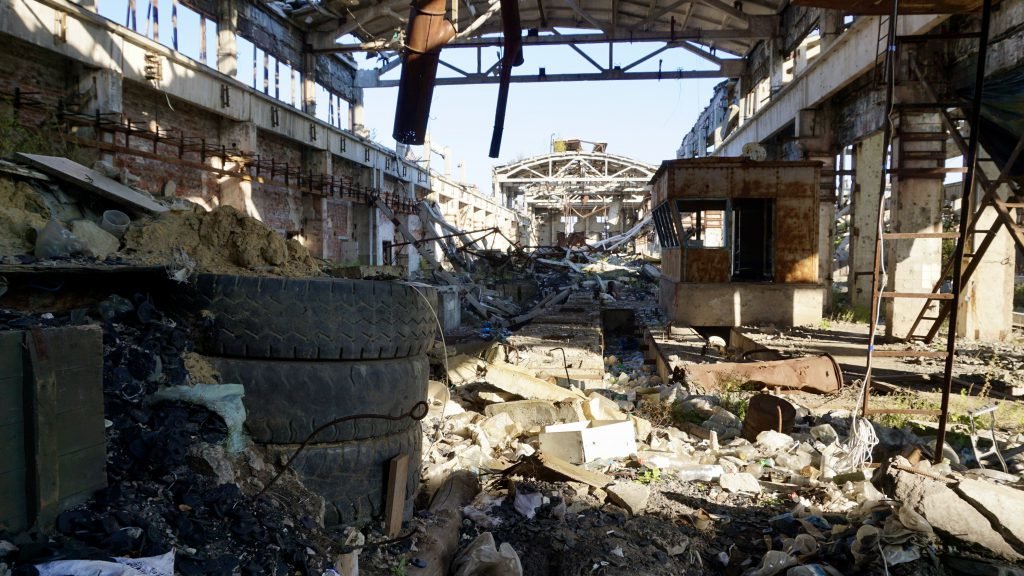
The position, known as Promka, is now controlled by Ukraine’s 25th Air Assault Brigade. The unit’s commander, Mykhailo, is a 24-year-old first lieutenant who has been at war since 2014 — practically his entire adult life.
“[The cease-fire] doesn’t work, since the enemy wants to make it look like we break it,” Mykhailo tells me at the edge of no man’s land. “They want to provoke us to shoot back with bigger weapons for all the international observers to observe and to say that we broke the cease-fire and not our enemies.”
Like many Ukrainian soldiers, Mykhailo asks that his full name not be published due to security concerns.
Opposite the narrow no man’s land at the factory’s far end, the Ukrainians have built a fortified barricade out of stacked rubble. The barrier seems more fitting for a Mad Max movie than a modern battlefield. At one spot, there sits a heated mannequin clad in military kit — a ploy to fool any Russian snipers using thermal scopes. “They see it as an alive human being,” Mykhailo says with a grin.
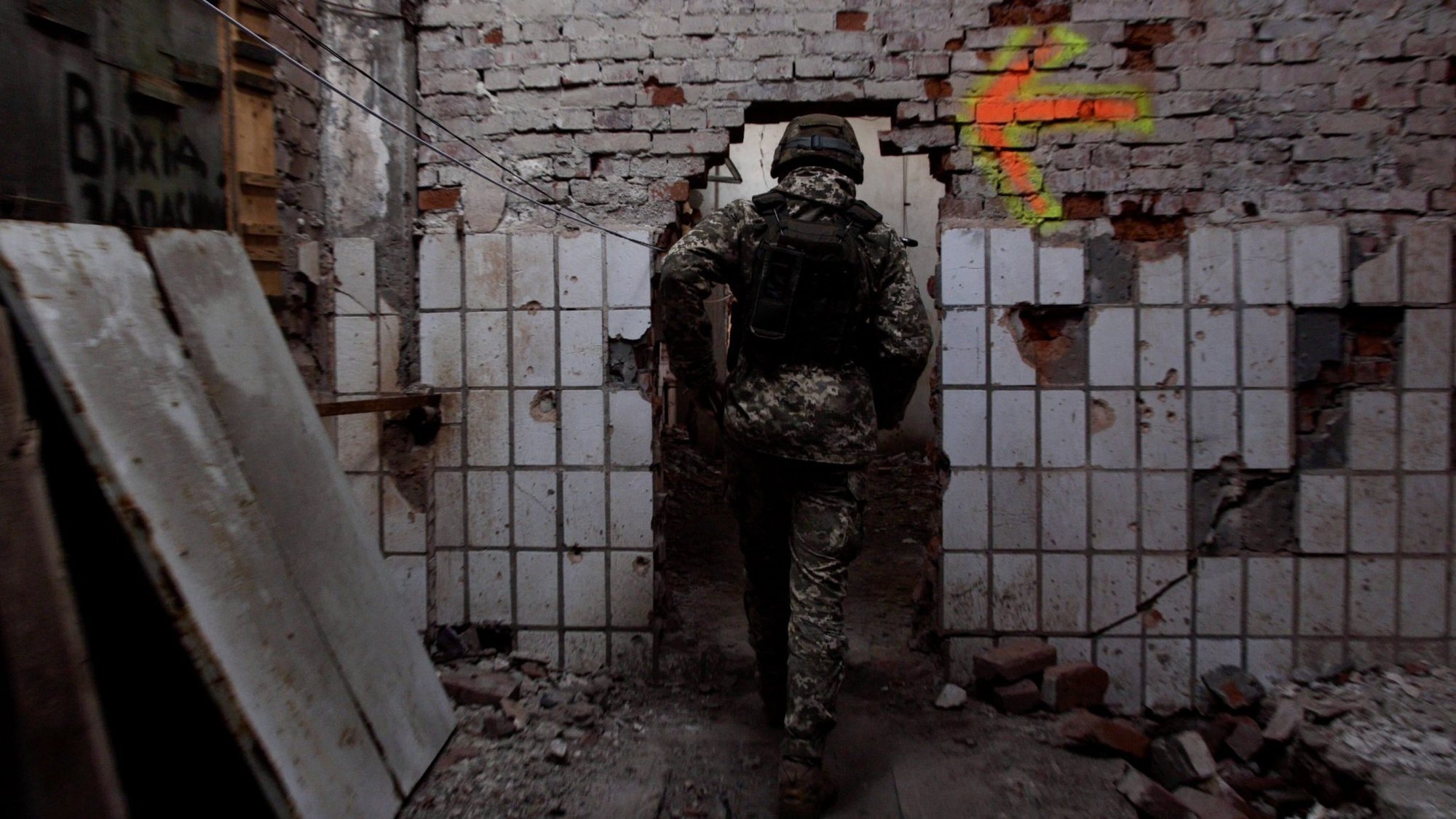
The fortified wall also contains an array of peek-holes — small trapdoors about the size of basketballs through which the Ukrainians steal quick glances at their enemies about 160 feet away. A 32-year-old Ukrainian soldier who goes by the nom de guerre “Warman” waves me up to one of these apertures. “There’s a tree in that direction,” he says, denoting the vector with his hand. “The Russians are there.”
I swallow my anxiety and raise my head to the opening. I look in the prescribed direction and see the tree. It seems so close that I could easily hit it with a tossed football, in other circumstances. Although I see no signs of movement, a chill runs down my spine. My mind flashes with an image of my head snapping back from a sniper’s bullet. Heeding the instinctive warning, I duck away.
“The ones who are not afraid are fools. We are all afraid,” Warman says.
A native Russian speaker from the city of Donetsk, which remains under de facto Russian occupation, Warman volunteered to fight in 2014 against what he describes as a Russian invasion. He’s been at war ever since.
“I saw for myself, military soldiers of the Russian Federation,” Warman says. “I am from the Donetsk region, so I am fighting for my motherland.”

After more than seven years, the war in Ukraine’s eastern Donbas region is far from over. Along a fortified front line about 160 miles in length — spanning a southwesterly arc from the Russian border to the Sea of Azov — Ukraine’s military continues to fight against a combined force of Russian regulars and pro-Russian separatists.
In October I undertook a weeklong trip to the Donbas war zone to observe Ukraine’s Joint Forces Operation, or JFO — Kyiv’s official name for the Donbas military campaign. I visited three key locations. Starting at the northern limit of the war zone near the occupied city of Luhansk, I continued onward to positions near the city of Avdiivka and then ended at the southern terminus of the front lines in the town of Shyrokyne, on the Sea of Azov coastline. Along the way, I interviewed Lt. Gen. Oleksandr Pavliuk, the commander of Ukraine’s Joint Forces Operation, at his headquarters in the city of Kramatorsk.
Europe’s only ongoing land war has killed some 14,000 people, and another 1.7 million have been displaced because of the fighting. The February 2015 Minsk II cease-fire froze the conflict along its current boundaries and generally limited its intensity by banning certain heavy weapons. But combat never ended. Daily shelling and sniper fire continue to take lives. So do small, weaponized Russian drones, which patrol high overhead and drop lethal explosives. Sixty-one Ukrainian soldiers have died since July 27, 2020, including five deaths in September.
The war has no sense of urgency. From what I observed, the Ukrainian side is not fighting to achieve a breakthrough or take back territory. Rather, they’re simply holding their ground, under daily fire, against what they say is a Russian invasion of their homeland. In conversation, the Ukrainians (both front-line troops and their commanders) uniformly refer to their enemies as “Russians” and scoff at the notion that they’re fighting in a civil war.
“The provocation can happen any minute,” says Pavliuk, the Joint Forces Operation commander. “We understand who is in front of us, understand how Russia wages war, and we are ready for an escalation, ready for new combat.”

According to Ukrainian military intelligence estimates, combined Russian-separatist forces include about 2,100 Russian military personnel who primarily serve as advisers and instructors. Those Russian troops reportedly serve within a larger force of 35,167 irregular soldiers drawn mostly from the two breakaway territories in Ukraine’s Donetsk and Luhansk regions. That combined force, according to Ukrainian intelligence officials, controls 484 tanks — more than twice the number of the British Army. While the lion’s share of fighting is not done by Russian soldiers these days, the campaign is sustained by Russian cash and armaments. For its part, Moscow denies having a hand in the war.
Altogether, the conflict blends modern weapons and technology with battlefield conditions similar to those of the World War I trenches. At some places, such as a Ukrainian forest redoubt near Stanytsia Luhanska, no man’s land can be several miles wide and ill defined. At others, such as the Promka position outside of Avdiivka, the Ukrainians and their enemies are close enough to trade shouted insults.
The static, stalemated war in the Donbas has effectively become a training ground for some of Russia’s newest combat technologies — especially small drones and electronic warfare assets. Additionally, the Russian side uses anti-tank guided missiles and drones to send POM-2 land mines across no man’s land. Each day, Ukrainian explosive ordnance disposal teams patrol the war zone for whatever weapons the Russians may have covertly sent over. The Donbas war zone has also become a finishing school for specialized Russian military personnel, such as snipers, who come to gain combat experience.
This has become a psychological battle in which soldiers deal with the daily threat of random death by snipers and shelling and drone strikes. Although no man’s land is measured in yards or miles, the gulf between life and death is never more distant than a few inches. Or seconds. Such is the reality of trench warfare. It doesn’t matter how good of a soldier you are, how much you’ve trained, or how many years of combat experience you may possess. In this kind of war, your chances of survival usually just boil down to raw luck.
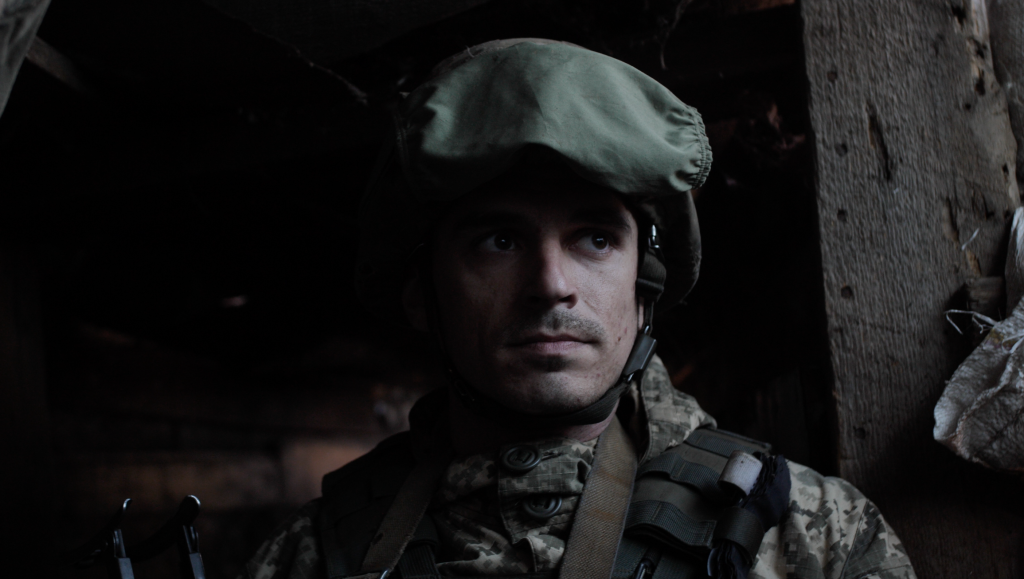
The Donbas trenches have now existed for twice as many years as those of World War I. Although the intensity is low, the war’s longevity exacts unique demands on the soldiers who fight in it. This is a war of attrition — but not in the physical sense. The Ukrainians’ overall objective, at this point, is not to exhaust their enemies’ reserves of men and materiel. Rather, they aim to exhaust their enemies’ resolve. The name of this objective is “stabilization operation.”
“[The war] is already here, and we must do some work to stop it. That’s all,” says Ivan, a 30-year-old first lieutenant serving with the 25th Air Assault Brigade at the Promka position near Avdiivka.
Ivan, who is married, has served in the war since it began in 2014. He’s approaching eight straight years of nonstop combat service, including harrowing battles that claimed the lives of 25 of his friends within the war’s first year. After all the friends he’s lost, and after so much missed time with his wife, Ivan’s hopes for peace have begun to wane. “Now I can’t see where this finishes,” he says. “Because it’s continuous already [for] seven years, and I don’t see where is it, the end.”
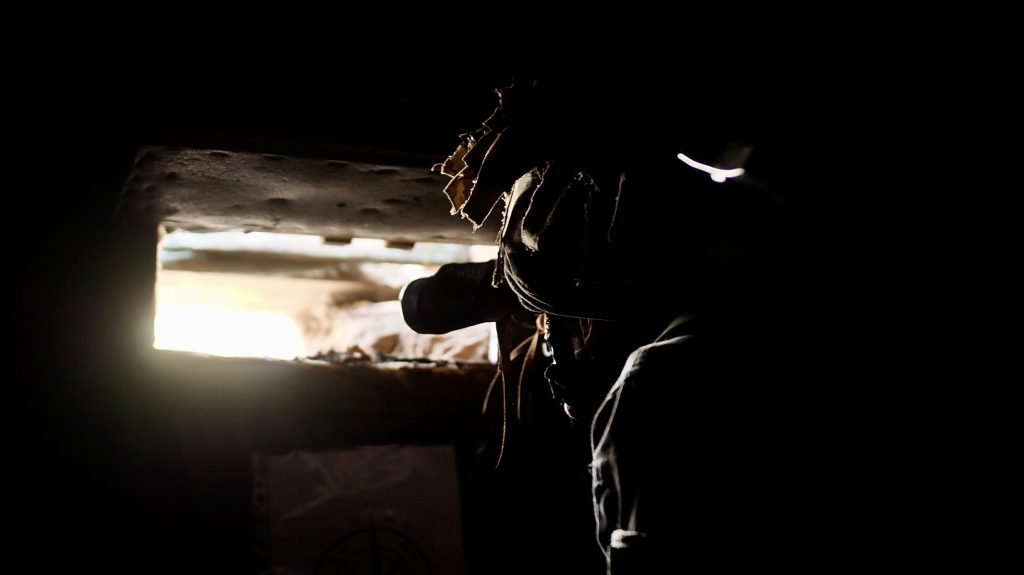
At the northern limit of the war zone outside of Luhansk, Ukraine’s 79th Air Assault Brigade is entrenched in a position near the town of Shchastya. To reach the lines, I embark with a squad of the brigade’s soldiers aboard a military transport truck. We jostle and snake through the woods to reach a rear echelon staging area, where we disembark and start our hike to the bank of the Seversky Donets River. Along the way, we pass a concealed encampment where Ukrainian soldiers are chopping wood in preparation for the coming winter. Their dugouts are built into the earth, embedded within a sloped hillside as protection against shelling. The soldiers have also constructed an outdoor grill, as well as a makeshift gym comprising dip and pullup bars. There’s even a trash can for collecting plastic water bottles. They’ve clearly dug in for the long haul.
After a few minutes on foot, we reach the river. Along with several soldiers, I board a small rubber raft. We keep our voices down while one soldier stands on the bow with a single oar and pulls us ahead. The scene reminds me of the Greek myth of Charon the boatman ferrying departed souls across the River Styx. It truly feels as if we are crossing from one realm to another. This war is a destination. Once you’re at it, you’re in it.
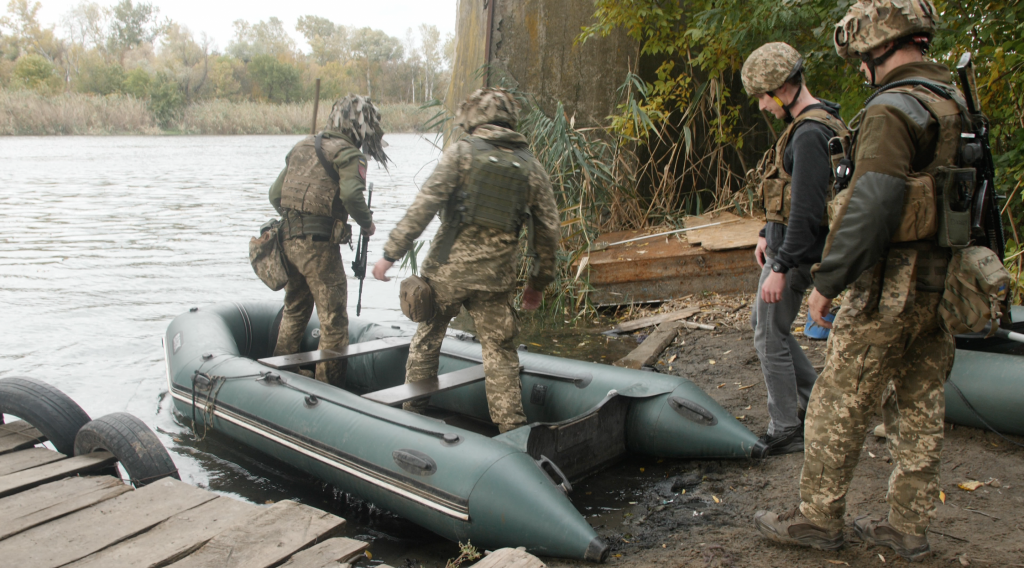
We land on the opposite bank and advance up a sharp rise. At the top, we enter the brigade’s front-line dugouts. Beyond this fortified line of underground tunnels, the Ukrainians are separated from their enemies by a mined strip only a few hundred meters wide. Inside the labyrinthine stronghold, it is dark and cold. Wooden beams buttress the earthen walls and ceilings. After a few twists and turns we emerge at a forward observation post. Beams of dull light from the overcast day come in through several crude openings. The Ukrainians advise me to stay away from the aperture that faces no man’s land. Just in case of snipers, they say.
From this space, the Ukrainians keep watch over their enemies through a binocular periscope. Through the glass, I’m able to observe the Russian lines for myself. Struck by the absurd proximity of the opposing camps, I ask the Ukrainian soldiers around me if it’s difficult to live so close to their enemies for so long.
“It just sounds strange,” says Volodymyr, a 40-year-old sergeant who is standing nearby. “But actually, nothing is strange. This is war.”
Later, I stand outside among several soldiers. A 38-year-old first lieutenant named Illia says they rarely gather in groups like this — such clusters offer armed drones an easy target. Nevertheless, Illia casually lights a cigarette and rests against a low wall. In between drags he holds his hands clasped in front. The day is cloudy and windy, and he seems to believe we’re in relative safety standing together in the open at this spot — about half the distance of a par-3 golf hole from the Ukrainians’ enemies.
“It puts you under constant pressure when you always expect something from the air,” Illia says of the drone threat. “It’s very hard to fight against it.”
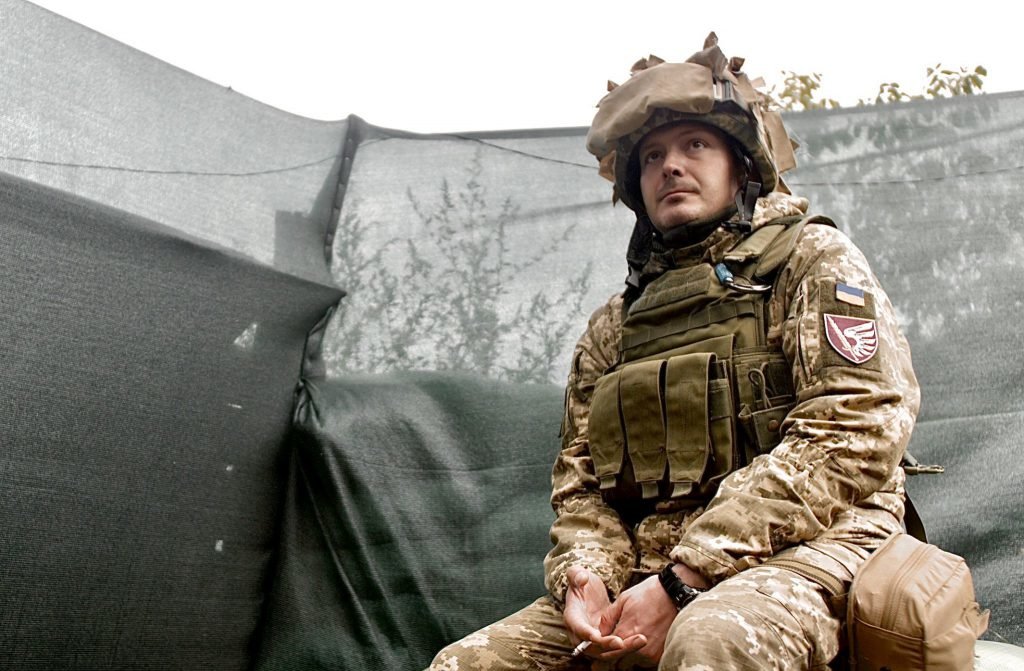
When the war began in 2014, Ukraine’s army was depleted by decades of corruption and able to field only a few thousand combat-ready personnel. Today, the Ukrainian army is a professional, disciplined fighting force. Its young officers are battle-hardened by years of conventional and unconventional warfare; they’re used to perpetual combat against a technologically capable enemy armed with tanks, rockets, and artillery.
The constant dangers keep soldiers on edge. Yet, one of the most demanding aspects of the war, from the Ukrainians’ perspective, is their restricted ability to retaliate while under fire.
“It is hard. We respond when we feel a threat, but we try not to react on their provocative shootings,” says Mykhailo, the Promka position commander.
If a Ukrainian unit comes under attack, the on-scene commander — such as Mykhailo — has the authority, on his own and without direct chain of command approval, to return fire with the Minsk II-approved weapons he has on hand.
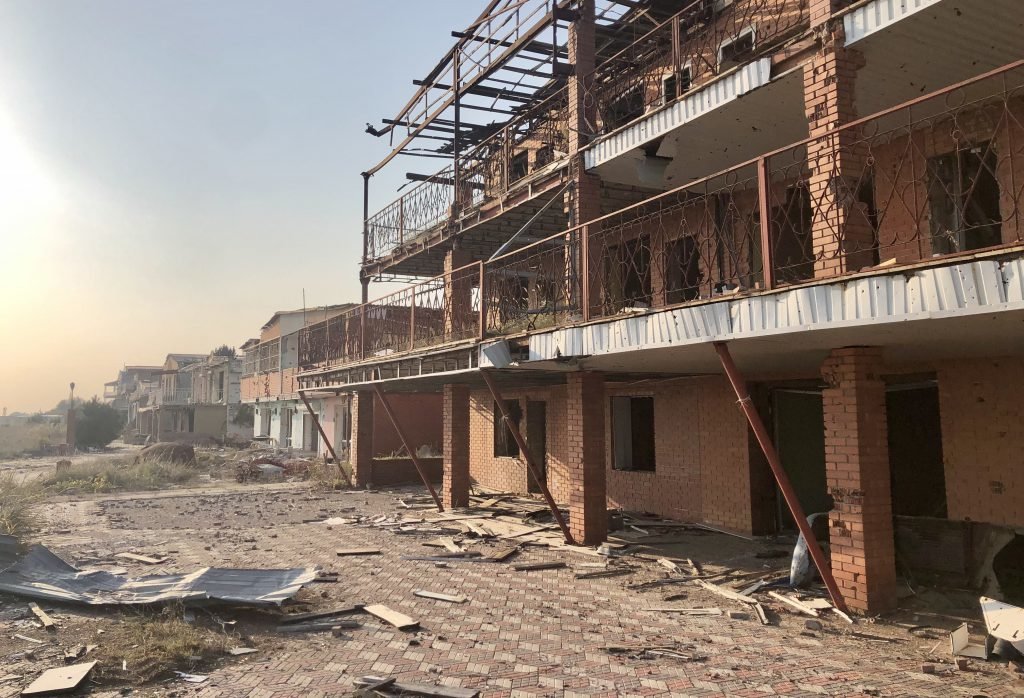
Currently, the Ukrainians return fire at about half the rate at which they are fired upon. In September, for example, Ukrainian forces fired back 107 times in response to 207 attacks from the combined Russian-separatist side. The Ukrainians are reluctant to shoot back for two key reasons. First, they understand that the Russians are looking to bait them into overreacting, which would give Moscow a pretense to escalate the conflict, should it so desire. Secondly, many attacks from the Russian side are likely designed to lure the Ukrainians into exposing their positions.
“Sometimes [the Russians] shoot in order to draw fire. In those cases, we do not react and stay cool; commanders ascertain the situation themselves,” Pavliuk says. “When [Ukrainian commanders] see danger, they respond to minimize the danger. If there is no danger, there is no need to waste ammunition. Moreover, there are a lot of situations when the enemy creates a provocation, wanting us to shoot back. First of all, to accuse us. And secondly, to put our soldiers under the bullets of their snipers.”
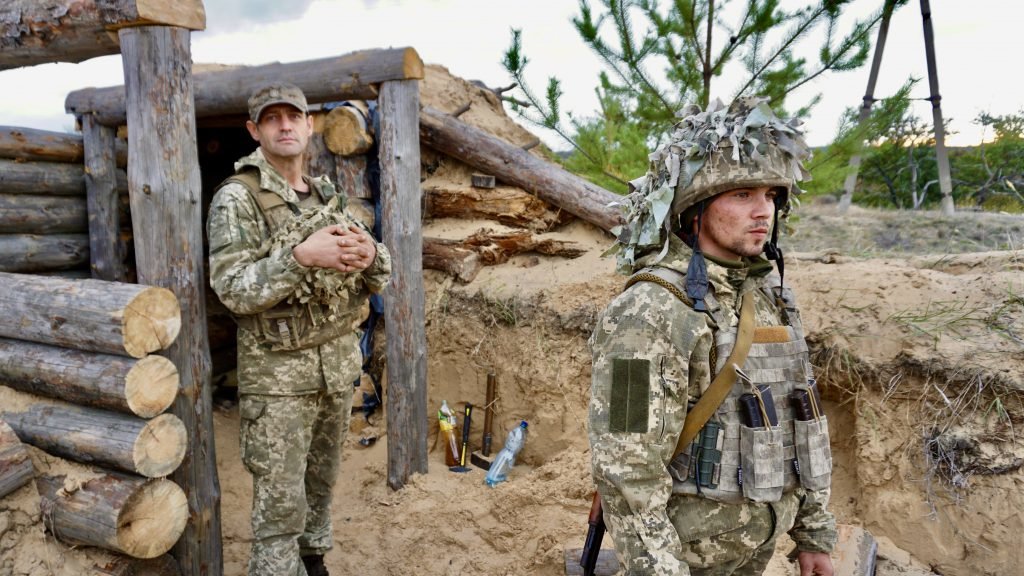
The Ukrainians have withdrawn the heavy weapons proscribed by the Minsk II cease-fire. Those weapons, however, are kept in reserve at rear echelon positions, ready to be rapidly employed in case of an enemy offensive.
If a unit sustains a particularly heavy attack, the on-scene commander can call up the chain of command and request the use of those heavier weapons kept away from the front lines. However, with retaliation decisions often hinging on the judgments of lieutenants in their early 20s like Mykhailo, and therefore subject to the passions of combat, an unscripted escalation remains a possibility. Nevertheless, the Ukrainian military balances that risk against the need to give its front-line forces the necessary latitude to defend themselves.
“Every unit has a right to use weapons on their own, on the order of their commander at the location, when the shooting endangers human lives. The priority is human life,” Pavliuk says, adding: “We have professional military personnel who have eight years of combat experience. We respond with dignity, hold our positions with dignity, and fulfill all the [cease-fire] agreements.”
The decentralized rules of engagement highlight a major cultural shift within the Ukrainian military, which mirrors the entire country’s ongoing cultural divorce from Russia and its Soviet heritage. Notably, the Ukrainian military is ridding itself of the Soviet chain of command model, in which decision-making was concentrated at the top and left junior officers and front-line troops with little flexibility to exercise their own initiative while under fire.
Today, front-line officers have the autonomy to make their own decisions in combat based solely on a higher commander’s pre-stated intent. Likewise, in another departure from the Soviet system, the role of sergeants is now the backbone of front-line forces. In sum, these changes have made Ukraine’s combat units much more adaptable to battlefield realities and less reliant on centralized directives from rear echelon headquarters.
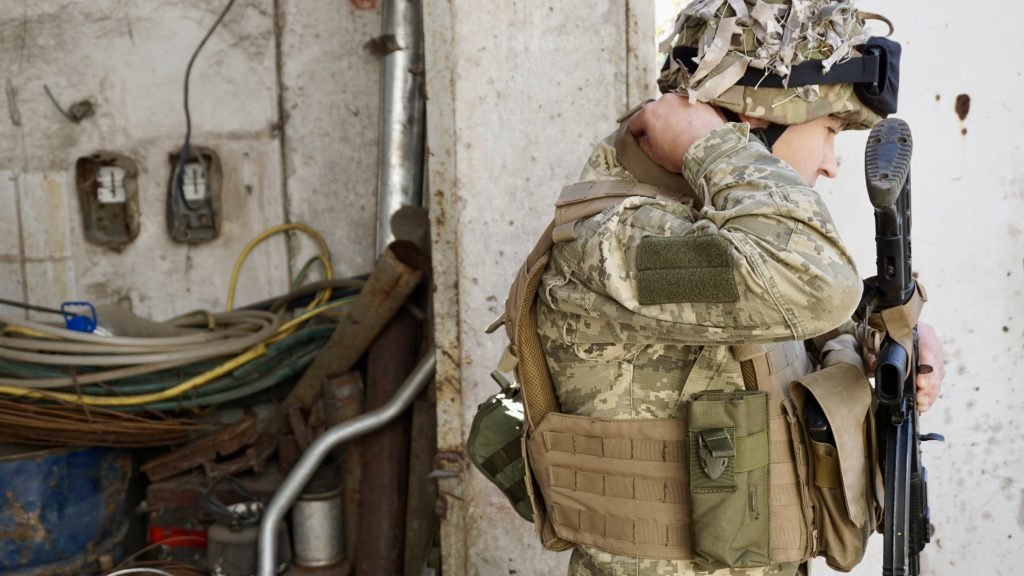
“During the Soviet Union the standard was mindless subordination to the chain of command,” Pavliuk says. “In contrast, we now have trust in every commander, with much less direct oversight compared with the Soviet chain of command rules. Every commander trusts his subordinates. And [combat operations] are most effective when each commander understands his responsibilities and makes decisions independently, apropos of the situation at hand.”
The Ukrainians have also adopted a preference for limited, precision weapons, thereby placing a decidedly un-Soviet premium on the preservation of human life — both military and civilian. “According to Soviet standards, the main thing was to complete the mission, and no one cared about the amount of human losses,” says Pavliuk, who began his military career in 1987 in the Soviet army.
“Our [NATO] partners have a completely different approach,” Pavliuk says. “And we took that perspective — that human life is a priority.”
From 2014 to 2015, front-line Ukrainian forces depended on civilian volunteers for most of their basic kit, as well as food and water. Today, the military meets its own basic needs without civilian help. Soldiers still complain about outdated weaponry and an overly bureaucratic process for requesting equipment. Overall, however, it’s a night and day difference from the war’s early years.
Looking back, it’s clear that Ukraine’s civil society volunteer movement spared the country from disaster and gave the regular army time to regroup and dig in for the long haul.
“We understood in 2014, when we entered the war, that there were many moments for which we weren’t prepared,” Pavliuk says. “But because of our Ukrainian spirit, spirit of a free nation, and the support of its people, the army could grow and be restored.”
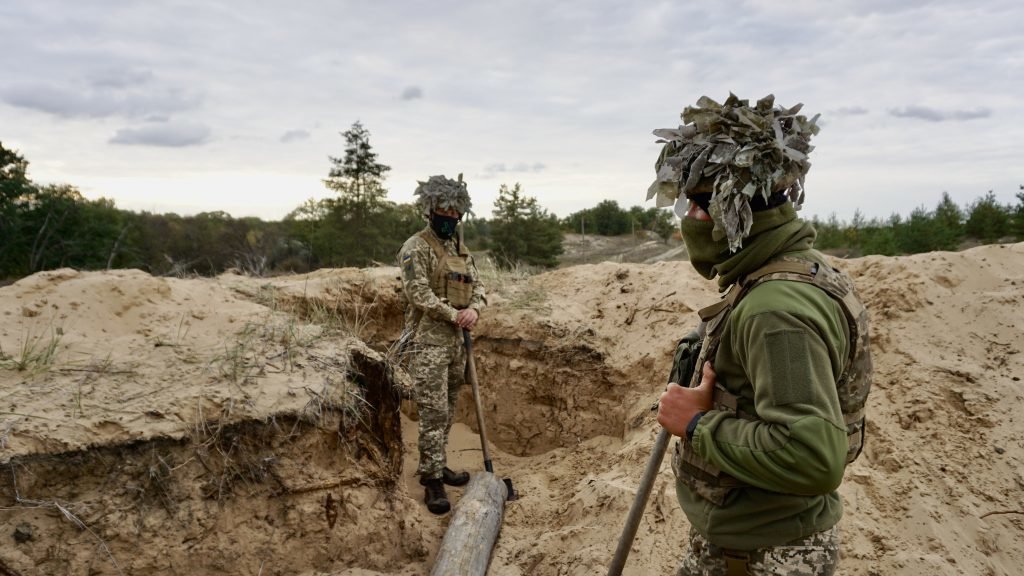
Since the war’s outset, the Ukrainians’ fortified positions have significantly improved. And their investments in intelligence have produced a comprehensive understanding of their enemy’s battlefield disposition. In both Shyrokyne and at the Promka position in Avdiivka, I visited tactical operations centers where Ukrainian specialists monitor video feeds from an array of cameras they’ve installed along the edges of no man’s land. These sensors have night vision capability, permitting 24/7 overwatch of the Russian side. And thanks to a computer program developed by a civilian volunteer, those battlefield cameras can also give precise GPS coordinates of what the user is viewing.
The Ukrainians are notably adept at enterprising innovative solutions to some of Russia’s modern military tactics and technologies. For example, to combat the threat of Russian electronic warfare units jamming or intercepting radio communications, front-line units typically rely on land-line communications — complete with old-school rotary phones, in places. The Ukrainians have learned to not rely on modern technological crutches like GPS, which the Russians also jam. Also, because the Russians can target their artillery on radio and cellular signals, Ukrainian soldiers only use radios in emergencies and maintain strict rules against cell phone use while on the front lines.

The most significant change in the war has been the prevalence of small drones, which carry out targeted strikes with dropped hand grenades and land mines. Russian drones, such as the Orlan UAV, have reportedly been dropping weapons from a height of about 4 kilometers, roughly 2.5 miles. At such an altitude, the drones are extremely difficult to detect. Resultantly, the Ukrainians have become significantly more “drone conscious.” They avoid gathering outside, especially in clear weather, and they now make a serious effort to camouflage their trenches and dugouts from aerial reconnaissance. During winter, after the leaves have fallen and there’s less natural concealment, Ukrainian troops pay particular attention to camouflaging their movements and positions.
If an enemy drone is detected by Ukrainian air defense systems or human spotters, the chain of command alerts the proximate front-line positions. Those troops then conceal their position from aerial observation. The Ukrainians also employ conventional weapons and electronic warfare tools to destroy drones, or interrupt their control signals.
For their part, the Ukrainians maintain strict rules about their own use of drones to avoid inadvertently escalating the conflict. For now, front-line units are reportedly not allowed to fly drones past the contact line and over enemy territory. Ukraine has amassed a fleet of the Turkish-designed Bayraktar TB2 drones, some of which are deployed to the Joint Forces Operation area. An unconfirmed Ukrainian news report stated that Ukrainian forces used the Bayraktar for the first time in combat on Oct. 26.

At a flat and forested position near the town of Stanytsia Luhanska, a detachment of troops from Ukraine’s 79th Air Assault Brigade have dug their shelters below ground level as protection against shrapnel. One stretch of the surrounding forest remains devastated by earlier shelling. Many tree trunks are felled and burnt like used matchsticks. If you’ve ever seen the Band of Brothers TV series about the Battle of Bastogne in World War II, this location visually resembles that battle space.
The Ukrainian soldiers burn wood for cooking and heat; solar panels provide some of their electricity. They travel between positions on foot or in Soviet-era, BMP-1 infantry fighting vehicles. Despite the MacGyvered look of their campsites, the troops all wear matching multicam uniforms and modern personal protective equipment, including new body armor plate carriers and helmets with night vision goggle mounts. Every soldier wears an individual first-aid kit, or IFAC, on his or her person.
Two weeks earlier, this area’s soldiers began building a new observation post atop a small rise facing Russian positions on a hillside about 2 kilometers away. Immediately after construction commenced, the Russians fired two anti-tank rockets at the spot. One missed widely; the other struck about 100 meters away from the Ukrainians’ new dugouts, leaving a crater in the sandy soil. Undeterred, the Ukrainian troops have continued their work.
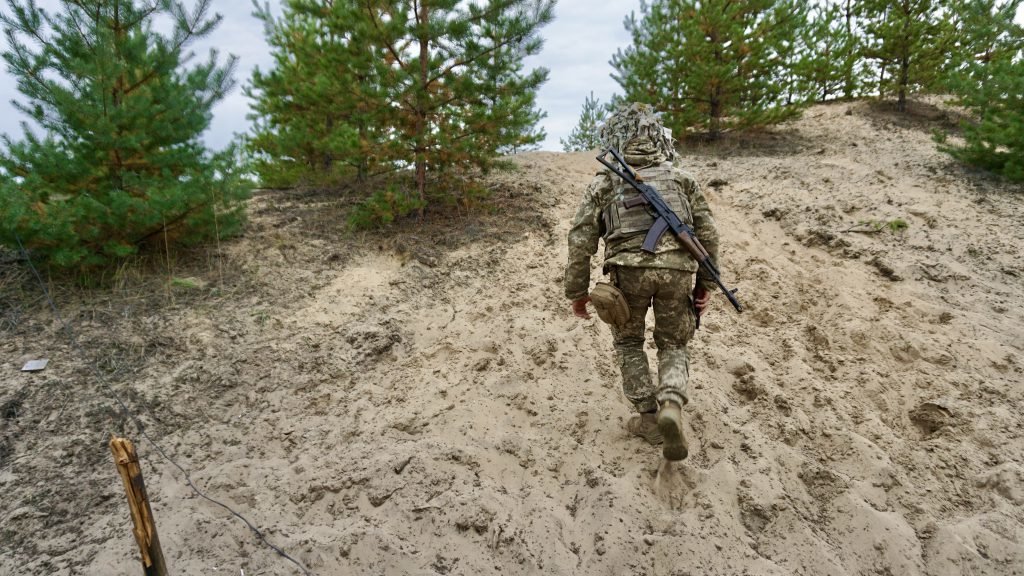
On this day, the new observation post has already been built and is linked by a trench to a cluster of underground shelters. A 23-year-old private first class named Pavlo leads me around the site. Short and solidly built, Pavlo moves purposefully around the encampment, pointing out where the soldiers sleep and eat. It’s unusual to have a foreign journalist out here, yet he willingly obliges my questions.
“Everyone feels fear,” says Pavlo, who is on his second combat tour. “The one who is not afraid has problems with his mental health. How can you not be afraid? Everyone is afraid.”
Typically, Ukrainian units rotate in for front-line deployments that last about nine months. These days, the entrenched, positional warfare they endure in the Donbas is less acute in its immediate dangers than the dynamic maneuvers of the war’s opening years. Even so, the static nature of the war frustrates some of the soldiers.
“It is hard to sit and observe when there is nothing is going on. It is hard,” Pavlo says. “If there is shelling, you know that no one is going to come here for you while the weapons are working and the missiles are flying…But when it is quiet, then it is really stressful to sit here and observe, making sure no one is trying to sneak up on you.”
The erstwhile industrial heartland of the Soviet Union, Ukraine’s Donbas region is where Soviet Premier Nikita Khrushchev once worked as a coal miner and began his ascent in the Communist Party. Most Ukrainians living in the Donbas primarily speak Russian. According to some, that makes them Russian-leaning in their political persuasions, too. But that’s not actually the case. Within government-controlled territory in the Donbas, it’s common to see Ukraine’s yellow and blue flag on display. Along the roads, billboards display recruitment advertisements for Ukraine’s armed forces. And no one seems to mind using the Ukrainian language, if asked.

Most of this region changed hands several times during the early years of the war. And many structures still bear the scars of combat — irregular shrapnel patterns and collapsed roofs and shrapnel-shorn tree trunks. The treads of tank convoys cleaved the asphalt on one particular stretch of highway. Now, tires spinning over the indentations produce a high-frequency hum. Locals have nicknamed it “the singing road.”
The war has also scarred the people living here. Some lost their homes. Some lost their jobs. Some lost friends and family to the fighting. Teenagers today were only children when the tanks and artillery cut back and forth across this embattled land in 2014 and 2015. They’ve spent the formative years of their life within earshot of the artillery. They can hardly remember life without war.
The most jarring part of any war is its intersection with normal life, and the war in Ukraine is no different. In some ways, the geographically quarantined nature of the conflict makes the parallel existence of war and peace so much more absurd. It can leave your head spinning to observe sunbathers lounging on a beach, or children attending elementary school, within a few hundred meters of the front lines.
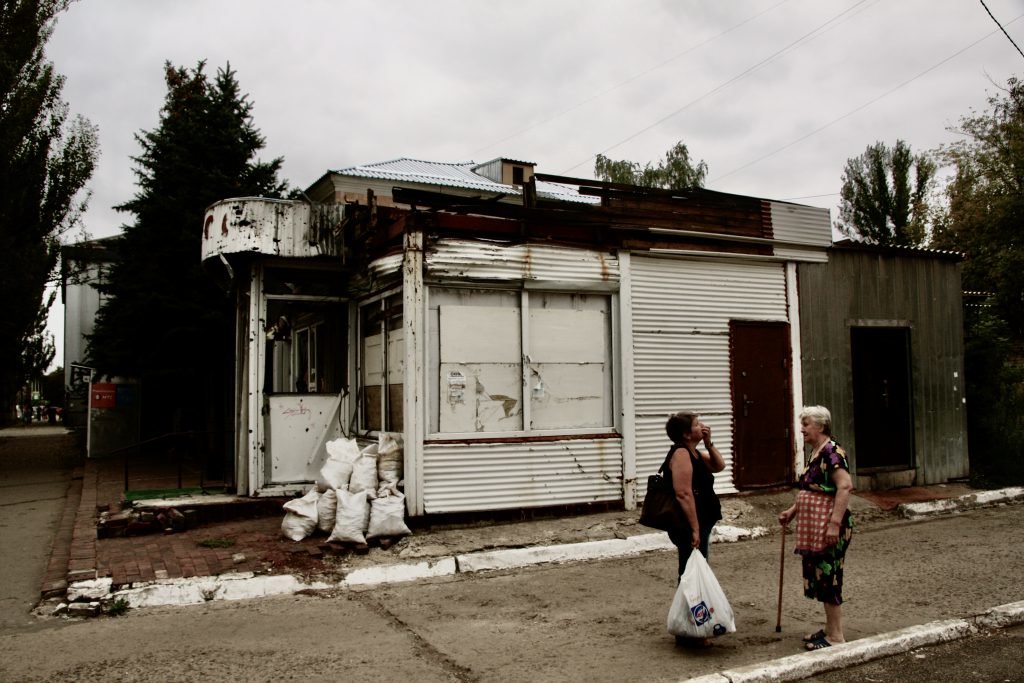
Many Ukrainian commanders and soldiers freely admit that there’s likely no military solution to the conflict. An all-out Ukrainian offensive to take back its occupied territories would likely result in massive civilian casualties and catastrophic infrastructure damage (which Ukraine would then have to pay to repair). And with Moscow freely distributing Russian passports within the occupied portion of the Donbas, a Ukrainian offensive would almost certainly spur Moscow to openly invade under the pretense of protecting its citizens.
Although the physical effects of combat extend only as far as the range of the weapons used, the unconventional edges of the Russo-Ukrainian war reach well beyond the Donbas battlefields. There is another ongoing battle to defend the sovereignty of Ukrainian citizens’ minds. “Military victory is just one component of the whole picture,” Pavliuk says.
“Yes, the war is a hybrid war, and it’s fought in multiple domains, especially information war,” the JFO commander continues. “Yes, all of our soldiers can retake any territory by force, but if the local people do not support them, it will be hard to stay there. That is why we work with the local people for them to support and understand the situation. But it is hard to do because the Russian propaganda machine is working hard…As far as I know, this propaganda works not only in Ukraine but in the whole world.”
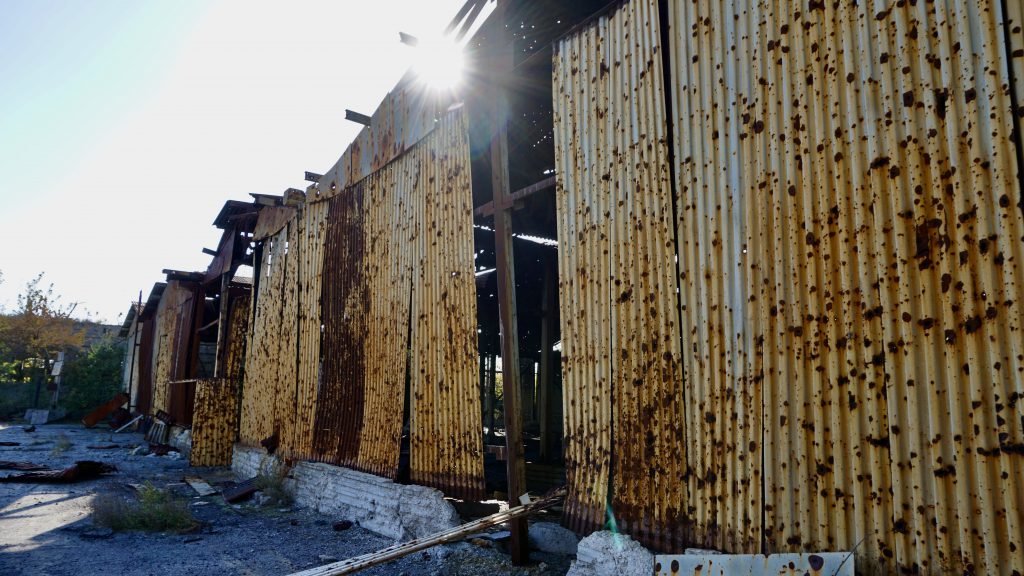
Ukraine’s 128th Mountain Assault Brigade controls the former resort town of Shyrokyne, which marks the southern terminus of the front lines on the Sea of Azov coast. This used to be a popular vacation spot for residents in the nearby cities of Mariupol and Donetsk. On this day, hardly a window isn’t shattered, and shrapnel scars pockmark practically every vertical surface. In places, years of shelling have carved and cratered the ground — occasionally, you see the fins of unexploded mortars protruding from the earth. Some trees are discolored by all the metal shrapnel embedded within their trunks.
“Every day our enemy violates the agreements, they violate the cease-fire. The shelling is constant,” says a soldier from 128th Mountain Assault Brigade who goes by the nom de guerre “Fast.”
“Drones, grenade launchers — every day we see the use of some new weapon,” the soldier says.
The local Ukrainian commander has the authority to order return fire with the weapons he has on hand. Adequate manpower is not an issue. In fact, the brigade has enough troops to periodically rotate some personnel off the lines for training.
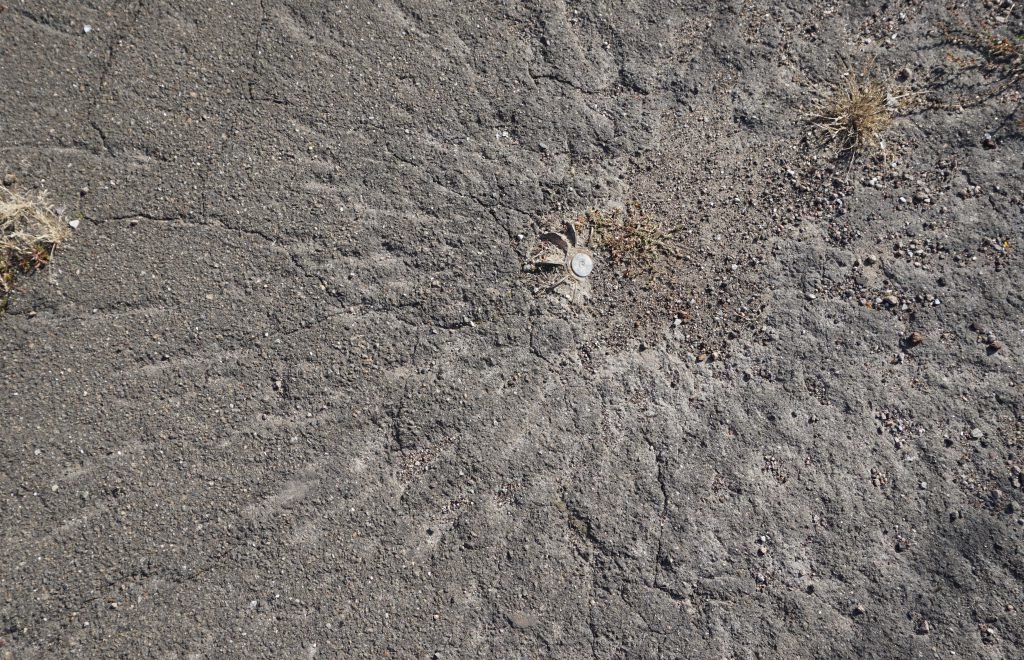
Shyrokyne is flanked by broad sand beaches — opportune terrain for an amphibious assault. Consequently, the Ukrainians have mined the area’s shallow waters and beaches and erected beach obstacles. They also maintain coastal artillery batteries and anti-aircraft defenses. According to the brigade, there’s never been a serious attempt by either side to outflank the other by sea. Still, the Ukrainians are on guard against the possibility of a Russian landing force. They maintain a database of the cargo capacities, technical capabilities, and drafts of Russian naval and merchant vessels. When spotters detect a ship offshore in the Sea of Azov, they cross-check this intelligence to gauge the potential threat.
Shyrokyne has changed hands several times throughout the course of the war. When they retreated, combined Russian-separatist forces reportedly left behind mines and booby traps. Consequently, Ukrainian soldiers generally stick to the pavement and avoid unnecessarily wandering through destroyed buildings or overgrown plots. Because of the threat of shelling, however, the Ukrainians still prefer to travel between positions in Shyrokyne on foot — the use of vehicles, especially trucks, is often too risky.
The Ukrainians estimate that about 100 to 150 enemy personnel are currently deployed in Shyrokyne’s immediate vicinity. There is a high amount of Russian drone activity in the area, and Russian electronic warfare vehicles are frequently observed arriving from the east, the direction of Russia’s border. As at other positions, the Russian side has demonstrated an ability to jam GPS, radio, and cellular signals. Communication is conducted via land lines. Radios are only used in emergencies, and cell phone use is forbidden.
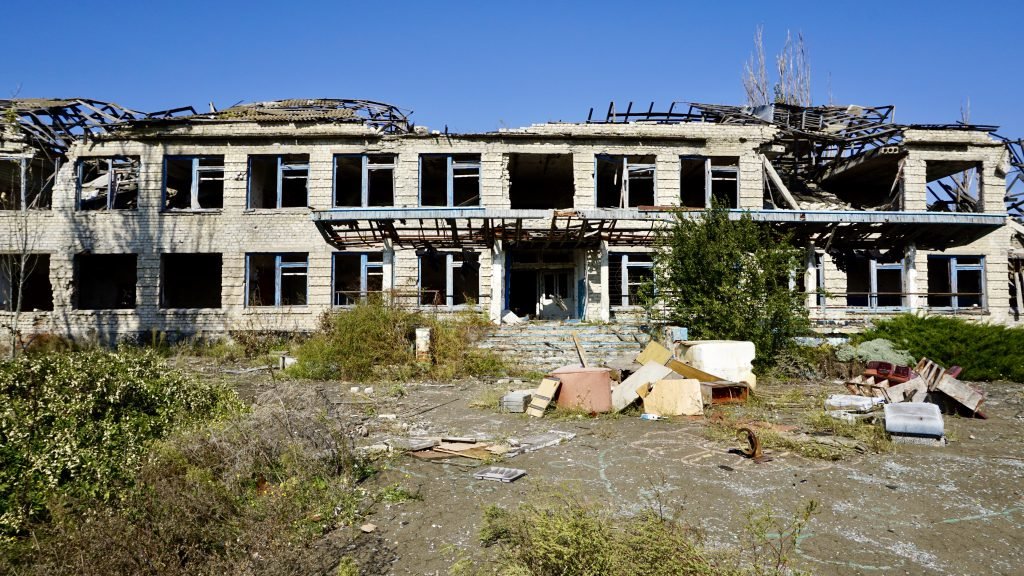
Today, there are no civilians left living in Shyrokyne. Inside many of the buildings, you see evidence of the lives of the people who used to live there and had to flee at a moment’s notice when the war began in 2014. Things like children’s toys, dishes, clothes, books. Stray dogs limp around town; they were wounded by shrapnel after their owners abandoned them in the mad rush to evacuate. Nature has reclaimed many of Shyrokyne’s buildings. Vines climb over shrapnel-speckled walls. Shoots of grass emerge from craters. The encroaching entropy resembles the abandoned town of Pripyat within the Chernobyl exclusion zone.
Yet, soldiers say it’s still common to see sunbathers on the beach a few miles to the west. And about 12 miles away, Mariupol is emerging from its post-Soviet doldrums — the industrial city is now home to hip craft cocktail bars and startup IT companies and trendy coworking spaces. The rumble of shelling in Shyrokyne is sometimes audible in the city center. But after more than seven years of war, Mariupol’s half-million civilians treat those far-off storms of steel as casually as a Floridian might register the threat of lightning from a distant thunderstorm. Yes, there’s lethal danger in the distance. But you don’t really take it seriously.
“I think that no one would have thought that the war would last for so long,” says the soldier nicknamed Fast. “Almost eight years and no one knows when it is going to end.”

Russia is the country’s paramount threat, according to Ukraine’s national security strategy. However, the demands of combat operations in the Donbas have slow-rolled plans to modernize all branches of the armed forces to resist a Russian invasion.
“Unfortunately, in my opinion, the pace of replacing old equipment is very slow,” Pavliuk says. “We still fight with Soviet equipment. But it’s because of our country’s economy. Because we need to support our armed forces that fight right now, and to repair the equipment that is constantly in the war.”
Despite its need to modernize, the Ukrainian military is able to sustain its campaign in the Donbas without US military aid. Even so, US military technology has markedly improved the survivability of Ukraine’s combat forces. Notably, units equipped with US counterbattery radar systems have seen sharp decreases in casualties from Russian shelling.
“We are thankful for all the help the USA provides us, because we needed it, especially at the beginning of the war,” Pavliuk says. “[The American military aid] affected our ability to defend while also keeping our people alive.”
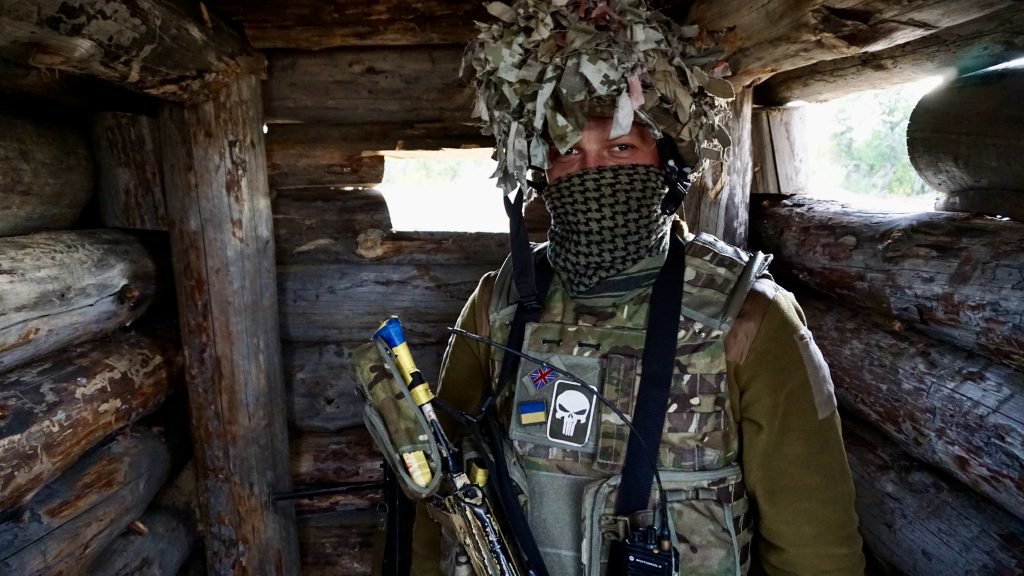
The American military hardware that has actually filtered to front-line Ukrainian units for daily combat use includes night vision goggles, counterbattery radars, encrypted radios, and sniper systems. Ukrainian troops invariably mention night vision goggles as the most useful American gear they’ve received. A number of US Javelin anti-tank missiles are also deployed to the war zone, but they are subject to strict restrictions and have not been used in combat.
Earlier this year, Russia massed thousands of troops along Ukraine’s borders, sparking fears of a wider war and prompting US forces in Europe to go on heightened alert. While that crisis seems to have passed, tensions remain elevated, and there’s little expectation that the conflict in the Donbas will end anytime soon. And with two of Europe’s largest land armies trading fire every day in the Donbas, there’s always the chance that this static, stalemated conflict will escalate into a far bigger and deadlier disaster.
“If we persevere, there is a chance of us being in the civilized world. If we lose — Russia won’t leave it at that,” Pavliuk says. “[Russia] thinks that they are a new world leader. … But, so far, they’re losing their teeth in Ukraine and cannot go any farther. Ukraine has potential, but it’s hard to take the punch alone.”
Read Next:

BRCC and Bad Moon Print Press team up for an exclusive, limited-edition T-shirt design!
BRCC partners with Team Room Design for an exclusive T-shirt release!
Thirty Seconds Out has partnered with BRCC for an exclusive shirt design invoking the God of Winter.
Lucas O'Hara of Grizzly Forge has teamed up with BRCC for a badass, exclusive Shirt Club T-shirt design featuring his most popular knife and tiomahawk.
Coffee or Die sits down with one of the graphic designers behind Black Rifle Coffee's signature look and vibe.
Biden will award the Medal of Honor to a Vietnam War Army helicopter pilot who risked his life to save a reconnaissance team from almost certain death.
Ever wonder how much Jack Mandaville would f*ck sh*t up if he went back in time? The American Revolution didn't even see him coming.
A nearly 200-year-old West Point time capsule that at first appeared to yield little more than dust contains hidden treasure, the US Military Academy said.












